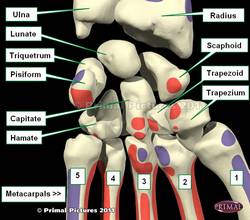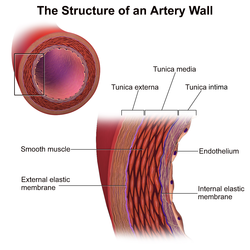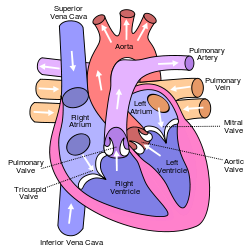
Medical Terminology Daily (MTD) is a blog sponsored by Clinical Anatomy Associates, Inc. as a service to the medical community. We post anatomical, medical or surgical terms, their meaning and usage, as well as biographical notes on anatomists, surgeons, and researchers through the ages. Be warned that some of the images used depict human anatomical specimens.
You are welcome to submit questions and suggestions using our "Contact Us" form. The information on this blog follows the terms on our "Privacy and Security Statement" and cannot be construed as medical guidance or instructions for treatment.
We have 2073 guests online

Georg Eduard Von Rindfleisch
(1836 – 1908)
German pathologist and histologist of Bavarian nobility ancestry. Rindfleisch studied medicine in Würzburg, Berlin, and Heidelberg, earning his MD in 1859 with the thesis “De Vasorum Genesi” (on the generation of vessels) under the tutelage of Rudolf Virchow (1821 - 1902). He then continued as a assistant to Virchow in a newly founded institute in Berlin. He then moved to Breslau in 1861 as an assistant to Rudolf Heidenhain (1834–1897), becoming a professor of pathological anatomy. In 1865 he became full professor in Bonn and in 1874 in Würzburg, where a new pathological institute was built according to his design (completed in 1878), where he worked until his retirement in 1906.
He was the first to describe the inflammatory background of multiple sclerosis in 1863, when he noted that demyelinated lesions have in their center small vessels that are surrounded by a leukocyte inflammatory infiltrate.
After extensive investigations, he suspected an infectious origin of tuberculosis - even before Robert Koch's detection of the tuberculosis bacillus in 1892. Rindfleisch 's special achievement is the description of the morphologically conspicuous macrophages in typhoid inflammation. His distinction between myocardial infarction and myocarditis in 1890 is also of lasting importance.
Associated eponyms
"Rindfleisch's folds": Usually a single semilunar fold of the serous surface of the pericardium around the origin of the aorta. Also known as the plica semilunaris aortæ.
"Rindfleisch's cells": Historical (and obsolete) name for eosinophilic leukocytes.
Personal note: G. Rindfleisch’s book “Traité D' Histologie Pathologique” 2nd edition (1873) is now part of my library. This book was translated from German to French by Dr. Frédéric Gross (1844-1927) , Associate Professor of the Medicine Faculty in Nancy, France. The book is dedicated to Dr. Theodore Billroth (1829-1894), an important surgeon whose pioneering work on subtotal gastrectomies paved the way for today’s robotic bariatric surgery. Dr. Miranda.
Sources:
1. "Stedmans Medical Eponyms" Forbis, P.; Bartolucci, SL; 1998 Williams and Wilkins
2. "Rindfleisch, Georg Eduard von (bayerischer Adel?)" Deutsche Biographie
3. "The pathology of multiple sclerosis and its evolution" Lassmann H. (1999) Philos Trans R Soc Lond B Biol Sci. 354 (1390): 1635–40.
4. “Traité D' Histologie Pathologique” G.E.
Rindfleisch 2nd Ed (1873) Ballieres et Fils. Paris, Translated by F Gross
"Clinical Anatomy Associates, Inc., and the contributors of "Medical Terminology Daily" wish to thank all individuals who donate their bodies and tissues for the advancement of education and research”.
Click here for more information
- Details
Medical terminology suffixes are sometimes formed by several components. The suffix component [-y] means "process" and can be used in many different ways.
A "process" can be an actual bony outcropping, a structure, or it can be an action or a series of actions.
Let's dissect a few suffixes to analyze their construction:
• [-(o)tomy]: This suffix is composed by [-tom-], derived from the Greek word [τομή] meaning "to incise" or "to cut". By adding the suffix component [-y] we obtain the meaning of "process of cutting".
• [-ectomy]: This suffix is more complicated. It originates from two Greek root terms εκτός meaning "out or outside" and "[tomos], which means "to cut" or "to open". By adding the suffix component [-y] we obtain the meaning of "process of cutting out". Other synonyms are: extirpation, excision, and removal.
• [-(o)logy]: The accepted meaning of this suffix is "study of", although a better meaning would be "process or action of studying". This suffix has an interesting evolution that you can read here.
The suffix [-y] can also be used alone, as in the case of the anatomical term mesentery. This term is of Greek origin. The prefix [mes(o)-] means "middle", the root term [-enter-] means "small intestine" or "intestine", and the suffix [-y] means "process" or "structure". Thus, the mesentery is "a structure in the middle".
- Details
The term [trapezoid] is formed by the root term [-trapez-] which arises from the Latin [trapezius] and itself a derivative of the Greek [τραπέζι] meaning "a small table", referring to an irregular four-sided shape. It also has the suffix [-oid] meaning "similar to". The word then means "similar to a four-sided table".
The Trapezoid bone is one of the four bones that comprise the distal row of the carpus or carpal bones that form the wrist. This bone is also known as the "lesser multiangular bone" because of its many angles, surfaces and sharp edges. The Latin name for this bone is os multtangulus minus.
The following text is from Gray's anatomy with annotations in []: "The superior surface, quadrilateral, smooth, and slightly concave, articulates with the navicular [scaphoid bone]. The inferior surface articulates with the proximal end of the second metacarpal bone; it is convex from side to side, concave from before backward and subdivided by an elevated ridge into two unequal facets. The dorsal [posterior] and volar [anterior] surfaces are rough for the attachment of ligaments, the former being the larger of the two. The lateral surface,convex and smooth, articulates with the greater multangular [trapezium bone]. The medial surface is concave and smooth in front, for articulation with the capitate [bone]; rough behind, for the attachment of an interosseous ligament."
The accompanying image shows the anterior (volar) surface of the wrist.
- Details
The root term [-carp-] arises from the Greek word [καρπό] meaning “wrist”. The adjectival form is [carpal] meaning “pertaining to the wrist”.
The carpus is a complex region between the hand and the forearm. It is composed by 8 bones arranged in two rows, as well as ligaments and joints that maintain the bones together and in position.
The proximal row is formed from lateral to medial by the following bones: scaphoid, lunate, triquetrum, and pisiform.
The distal row is formed from lateral to medial by the following bones: trapezium, trapezoid, capitate, and hamate.
The accompanying image shows the anterior (volar) surface of the wrist. Click on the image for a larger picture. More information on the wrist and its joints will be published soon.
Image modified from the original: "3D Human Anatomy: Regional Edition DVD-ROM." Courtesy of Primal Pictures
- Details
The term [capillary] is derived from the Latin word [capillus], which refers to a hair of the head.
Capillaries are the smallest components of the cardiovascular system, microscopic vessels that are actually thinner than a hair. Most capillaries are shorter than 1mm in length and their diameter is so narrow that it allows for red blood cells to only pass single file through them (see accompanying video). This accounts for a slow passage of blood through the capillary allowing for exchange of gases and nutrients between the vessel and surrounding tissues.
Capillaries are formed by a single cell wall known as endothelium. In the video, you can see a capillary clearly at the center of the screen, the reverse of flow and movement at the end of the video is an artifact.
Thanks to Stephen Taylor for the use of his video on YouTube.
- Details
UPDATED: The term [artery] evolved from two Greek words. The first one is [αέρα], meaning "air", and the second one is [terein], a verb meaning "to keep" or "to maintain"1. [Artery] therefore means "to maintain or to keep air", which is furthest from what we know today! The reason is that initial observations on these structures happened in bodies after combat, or gladiators who had exsanguinated because of their wounds. The arteries were empty (full of air) or contained a mix of blood and air. Arteries were considered a type of windipe. In fact, the original anatomical term for trachea was that of [tracheartery], which means "the rough artery". We have learned since then the true function of the arteries, so the name was shortened to "trachea".
The modern definition of an artery is "a structure that takes blood away from the heart". The amount of oxygen within the vessel has no bearing on the definition; there are arteries that carry oxygenated blood and arteries that carry deoxygenated blood.
Histologically, an artery is composed of three layers. The external layer is called the "adventitia" or "tunica externa". It is composed mostly of connective tissue. The middle layer is called the "tunica media" and is composed by a varying number of elastic fibers and smooth muscle fibers arranged as shown in the image. The inner layer is called the "tunica intima". The inner portion of the tunica intima is called the endothelium.
Arteries that are closer to the heart have more elastic fibers in their tunica media. As we move further away from the heart arteries become smaller and increase the number of smooth muscle fibers. This is what histologists describe "elastic arteries" and "muscular arteries". The smallest muscular arteries are called "arterioles". Large arteries have their own blood supply, called the "vasa vasorum".
Sources:
1. "The ancient Hellenic and Hippocratic origins of head and brain terminology" Panourias IG, Stranjalis G, Stavrinou L, Sakas DE. Clin Anat 2012 Jul;25(5):548-581
2. Image: "Blausen Gallery 2014" - Wikiversity Journal of Medicine. DOI:10.15347/wjm/2014.010. ISSN 20018762. Licensed under Creative Commons Attribution 3.0 via Wikimedia Commons - Original image
- Details
Although blood circulation is one constant circle of flow, it consists of two subsystems: pulmonary and systemic circulation mediated by the heart. Within the systemic circulation there are other subsystems: coronary, portal (hepatic), and renal.
Deoxygenated blood comes into the right atrium of the heart. The blood coming from the body does so by way of the superior vena cava and the inferior vena cava. The blood coming from the heart does so by way of the coronary sinus, the anterior coronary veins, and the venae cordis minimae. Thus, the right atrium receives the blood return from the whole body, including the heart.
From the right atrium, the deoxygenated blood passes through the tricuspid valve (one of the two atrioventricular valves) into the right ventricle. Upon contraction of the right ventricle (ventricular systole) blood is propelled through the pulmonary (sometimes called pulmonic) valve into the pulmonary trunk. The pulmonary trunk divides into a right and a left pulmonary artery, each of which enter a lung, thus starting pulmonary circulation.
Within the lung the arteries divide until they form a minute capillary meshwork around the alveolar sacs. At this point the deoxygenated blood discharges its CO2 and gains O2, becoming oxygenated blood which converges back towards the heart by way of pulmonary veins.
The oxygenated blood enters the left atrium by way of the four pulmonary veins. It passes into the left ventricle through the mitral valve (also known as the bicuspid valve), then it exits through the aortic valve and into the aorta. This starts systemic circulation.
The aorta and its branches provide oxygenated blood to all the body. Once the blood is deoxygenated, it comes back to the right atrium of the heart where the cycle starts again.
As a side note, all the vessels that enter or leave the heart are known as the great vessels. How many are the great vessels? For the answer, click here.




